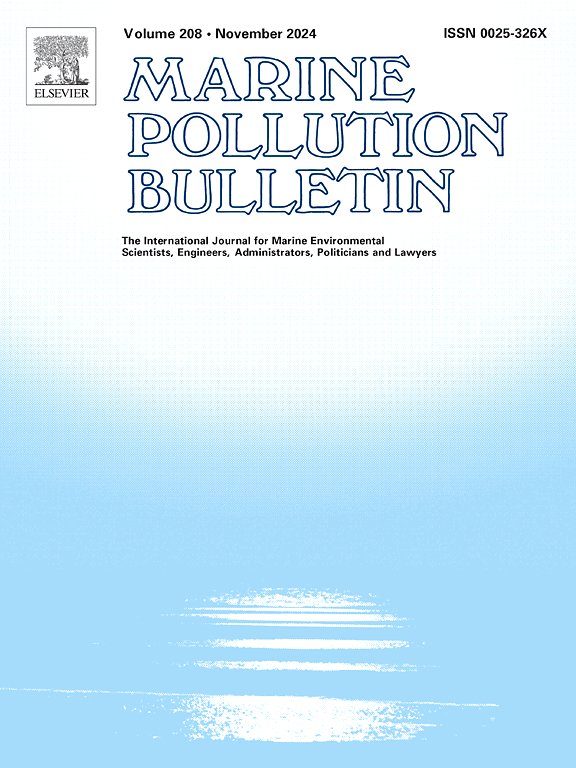有毒金枪鱼的故事:追踪鲭金枪鱼(Euthynnus affinis),长尾金枪鱼(Thunnus tonggol)和子弹金枪鱼(Auxis rochei)的微塑料途径。
IF 5.3
3区 环境科学与生态学
Q1 ENVIRONMENTAL SCIENCES
引用次数: 0
摘要
微塑料污染给全球海洋生态系统蒙上了阴影,成为一种可怕的威胁,但它对具有重要商业价值的海洋鱼类的影响在很大程度上仍未得到探索。本研究深入研究了居住在马来西亚水域的三种金枪鱼(Euthynnus affinis, Thunnus tonggol和Auxis rochei)的微塑料污染领域,重点关注胃肠道(GIT),鳃和可食用肌肉。选择这些物种是因为它们具有重要的生态作用和相当大的商业价值,在全球范围内被广泛捕捞和消费。仔细检查125个金枪鱼标本,发现了不同物种的污染水平,其中T. tonggol的浓度最高(每克1.22±0.14微塑料)。值得注意的是,相对于雌性金枪鱼,雄性金枪鱼表现出明显的微塑料积累倾向。值得注意的是,微塑料的形态主要包括纤维(92.43%),特别是黑色色调(63.25%)。值得注意的是,0.01-1.00毫米尺寸范围内的微塑料占据主导地位,占总量的61.54%,其中人造丝成为领先的聚合物(54.39%)。这些发现强调了GIT和鳃作为金枪鱼微塑料积聚的主要部位的关键作用,引起了人们对海鲜消费对人类健康潜在影响的担忧。加深我们对海产品中微塑料分布和特征的理解,以制定有效的减缓战略,并在海洋环境中保障人类福祉,这一点至关重要。这项研究呼吁全球紧急关注海洋生态系统中微塑料污染对生态和人类健康的影响。本文章由计算机程序翻译,如有差异,请以英文原文为准。

Toxic tuna tales: Tracing microplastic pathways in mackerel tuna (Euthynnus affinis), longtail tuna (Thunnus tonggol), and bullet tuna (Auxis rochei)
Casting a shadow upon marine ecosystems worldwide, microplastic pollution emerges as a formidable threat, yet its repercussions on commercially significant marine fish remain largely unexplored. This investigation delves into the realm of microplastic contamination within three tuna species (Euthynnus affinis, Thunnus tonggol, and Auxis rochei) inhabiting Malaysian waters, with a keen focus on the gastrointestinal tract (GIT), gills, and edible muscle. These species were chosen due to their significant ecological roles and considerable commercial value, being extensively fished and widely consumed across global regions. Scrutinising 125 tuna specimens uncovers a spectrum of contamination levels across species, with T. tonggol registering the highest concentration (1.22 ± 0.14 microplastics per gram). Remarkably, male tunas exhibit a discernible proclivity towards heightened microplastic accumulation relative to their female counterparts. Noteworthy morphotypes of microplastics predominantly encompass fibres (92.43 %), notably manifesting in black hues (63.25 %). Notably, microplastics spanning the 0.01–1.00 mm size range assert their dominance, constituting a substantial 61.54 % of the total, with rayon emerging as the leading polymer (54.39 %). These findings highlight the pivotal role of the GIT and gills as primary sites of microplastic accumulation in tuna, raising concerns about potential human health implications through seafood consumption. It is crucial to deepen our understanding of microplastic distribution and characteristics in seafood to develop effective mitigation strategies and safeguard human well-being within marine environments. This study advocates for urgent global attention to address the ecological and human health impacts of microplastic contamination in marine ecosystems.
求助全文
通过发布文献求助,成功后即可免费获取论文全文。
去求助
来源期刊

Marine pollution bulletin
环境科学-海洋与淡水生物学
CiteScore
10.20
自引率
15.50%
发文量
1077
审稿时长
68 days
期刊介绍:
Marine Pollution Bulletin is concerned with the rational use of maritime and marine resources in estuaries, the seas and oceans, as well as with documenting marine pollution and introducing new forms of measurement and analysis. A wide range of topics are discussed as news, comment, reviews and research reports, not only on effluent disposal and pollution control, but also on the management, economic aspects and protection of the marine environment in general.
 求助内容:
求助内容: 应助结果提醒方式:
应助结果提醒方式:


